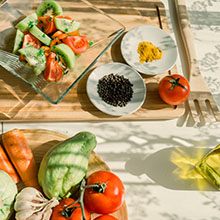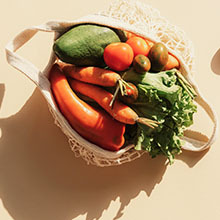With back-to-school season underway, parents and students alike are thinking of lunchbox ideas, including which fresh, tasty fruits and vegetables to pack. But with the price of food on the rise, health- and budget-conscious lunch-makers might be torn between paying the premium to go organic or paying less to stick to conventional produce.
A price check at your local supermarket can show the average price of organic produce ranging anywhere from a noticeable-but-possibly-manageable 50 cents to a staggering $3.00 more than its conventional counterpart. For instance, organic apples could be 50 cents per pound more than conventional apples, while a package of organic spinach might run you an extra three bucks. Those extra costs can easily pile up, especially if you’re on a tight weekly or monthly budget.
So here’s the pressing question: Is going organic worth the additional cost? The Environment Working Group (EWG)’s annual “Dirty Dozen” and “Clean Fifteen” suggests that it depends on what you want to buy.
Also known as EWG’s Shopper’s Guide, these lists highlight the fruits and vegetables containing the most and least pesticide residue. The EWG relies on U.S. Department of Agriculture and Food and Drug Administration testing of more than 38,000 washed or peeled samples of popular fruits and veggies for pesticide contamination. This year (2018), the EWG marked the following produce as the dirtiest:
- Strawberries
- Spinach
- Nectarines
- Apples
- Grapes
- Peaches
- Cherries
- Pears
- Tomatoes
- Celery
- Potatoes
- Sweet bell peppers
On the other end of the spectrum, the EWG found these popular produce items to contain very small amounts of pesticides:
- Avocados
- Sweet corn
- Pineapples
- Cabbages
- Onions
- Frozen sweet peas
- Papayas
- Asparagus
- Mangoes
- Eggplants
- Honeydew melons
- Kiwis
- Cantaloupes
- Cauliflower
- Broccoli
Shoppers can use the Dirty Dozen and Clean Fifteen to go organic for fruits and vegetables topping the “Dirty” list and save some money by sticking to non-organic for cleaner produce. While these are helpful guides if you’re looking for healthier options without hurting your wallet, they raise another question: Does organic really mean pesticide-free?
Are organic foods pesticide-free?
Many people assume that organic produce don’t contain pesticides, but that’s not entirely true.
“While most synthetic products and fertilizers are prohibited in the making of organic goods, pesticides from natural sources may be used,” explains Carolyn Young, Executive Director of the Organic Council of Ontario.
“Some synthetics are allowed, but it’s extremely restricted,” Young adds. “Plus, the level of toxicity to which they’re used are different.” According to the Organic Trade Association, more than 900 synthetic pesticide products are registered for conventional farming, while only 25 are allowed in organic crop production.
People are quick to equate the term “organic” with “spray-free,” but doing so is problematic. “Terms like ‘no-spray’ or ‘spray-free’ aren’t regulated, so anyone can use it,” Young clarifies. “But ‘organic’ is a regulated term and there’s a thoughtful process around what it means.”
Organic production isn’t just about the reduction of pesticides. “Being organic means encouraging farmers to integrate a system of care that promotes a healthy, balanced ecosystem – above and below the soil – that prevents pests from becoming a problem,” Young says. “This includes more thoughtful crop rotations, a diversity of crops and practices that promote animal welfare.”
Why is organic food more expensive?
With all these health considerations, it isn’t too surprising that organic produce and packaged foods cost more. For starters, they’re more expensive to produce. Farmers can grow conventional produce with a number of cheap, synthetic pesticides and fertilizers, which lets them cut down on costs. Organic growers, however, must abide by strict regulations that prohibit these chemicals. Additionally, using fewer pesticides can decrease shelf life, which can lead to higher costs at the wholesale and retail levels.
What’s more, organic labelling requires certification. “For a product to bear the Canada Organic logo, it must comply with the federal government’s Organic Products Regulations (soon to be the Safe Food for Canadians Regulations), which require products to be certified to the Canadian Organic Standards,” Young says. This means organic farmers and producers have to pay annual certification fees for each category of product (e.g., field crops, livestock, maple products, honey, etc.) they intend to sell. For small farmers producing a range of crops and products, these costs can be a financial burden. At the farmers’ market, you may even hear farmers saying their produce is grown organically, but they haven’t paid for the certification, or completed the certification process. Without the logo, however, you only have their word for it.
Ultimately, several health, economic and agricultural factors contribute to the price hike you see at grocery stores, according to the Organic Council of Ontario. But user-friendly guidelines like the Dirty Dozen and Clean Fifteen can give you a good sense of when it’s best to shell out an extra few dollars for organic.
But what do organic activists like Young think about people only buying organic some of the time?
“Roughly 88% of Canadians purchase organic products weekly,” Young says. “Nobody is going 100% organic. I think we know that going organic is aspirational and people make the choice to buy organic if and when they can.”
Young adds that for some Canadians, purchasing organic goes beyond saving money or looking after their health: “Canadians are also interested in improving the welfare of farmers and the ecology of the agricultural landscape. If you’re purchasing organic for more than just health reasons, than I would encourage you to look beyond the Dirty Dozen list.”
Growing your own or shopping at the farmers’ market
As an alternative, if you have a backyard, a patio or even just a balcony, you can grow at least some of your own organic produce. “Growing organic in your home garden is relatively easy,” Young notes. “To do so, you’ll have to know the requirements of the crops you plant, pay attention to soil health and grow a diversity of plants that complement each other.” To learn more about organic growing resources and practices, Young suggests you browse through the Canadian Organic Growers’ site.
Don’t have time or space for your own organic garden? No problem. It’s farmers’ market season in Canada right now, and organic produce is featured at many markets.




